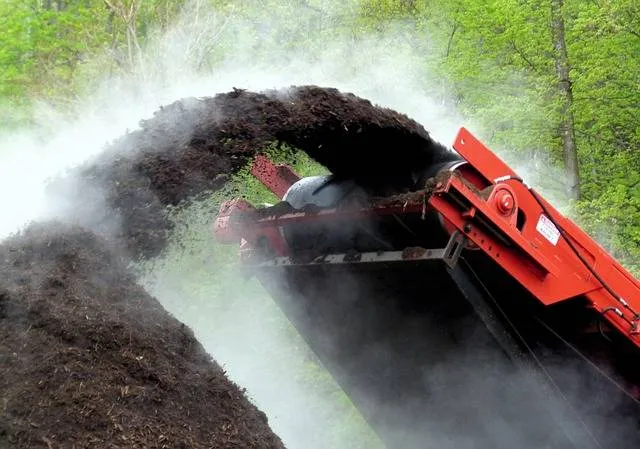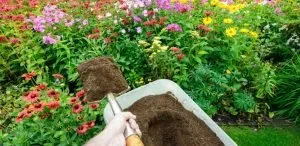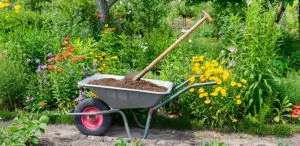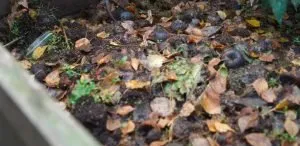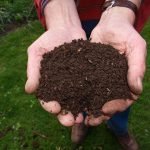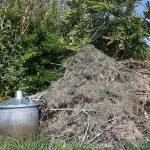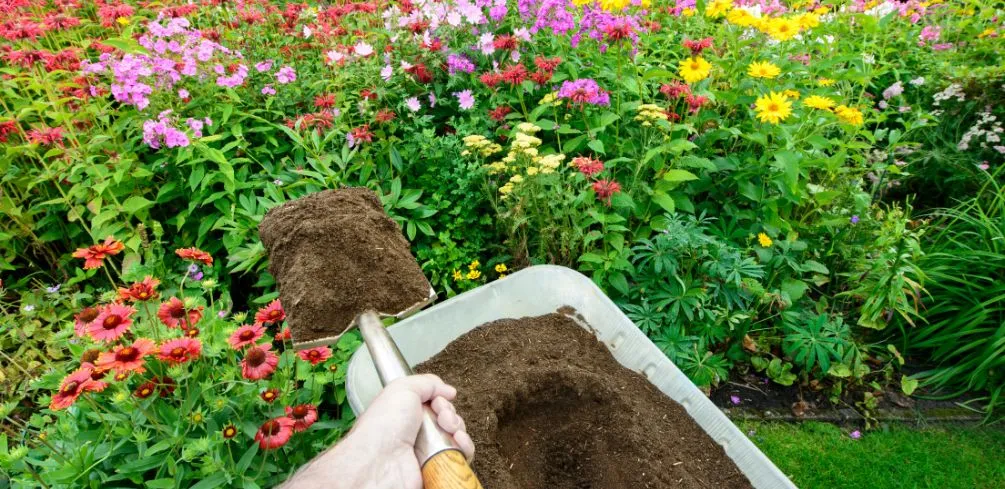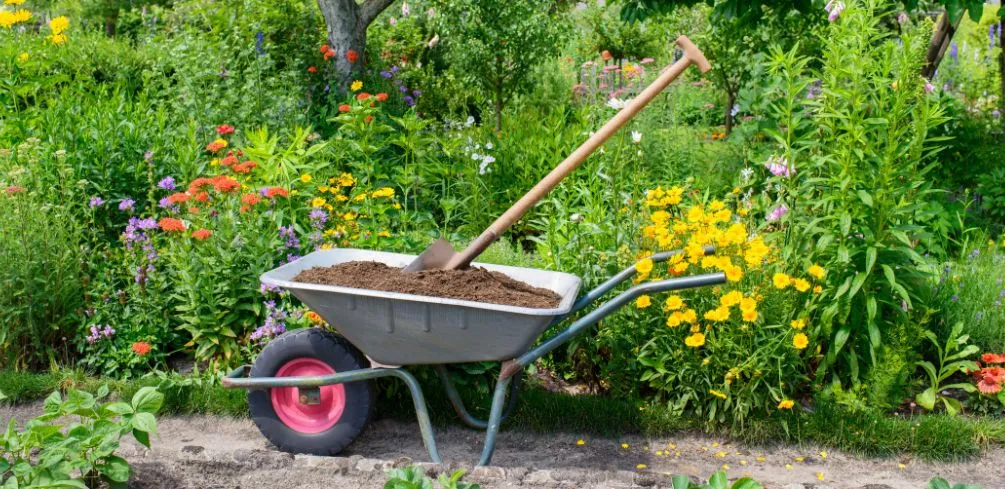Compost is an important element of the natural environment, contributing to the health and fertility of the soil. Preparing compost in a mindful way can help maximize its benefits while minimizing waste and pollution. This article will discuss how compost is prepared, highlighting the different steps involved in the process.
The preparation of compost involves multiple stages, beginning with the sourcing of raw materials. Organic materials such as leaves, grass clippings, kitchen scraps, and manure are all suitable for use in composting.
The materials should then be mixed together in order to create an even balance between carbon and nitrogen-rich sources. It is also important to ensure that the mixture has adequate moisture content; too much water can lead to anaerobic decomposition, while too little water can slow down the decomposition process.
Once these steps have been completed, it is time to begin the actual process of composting. This involves providing proper aeration and temperature control to promote microbial activity and accelerate decomposition. The finished product should contain a dark-brown crumbly material with a pleasant earthy smell, indicating that it is ready for use as organic fertilizer or soil amendment for gardening projects.
Definition Of Composting
Composting has become a popular topic among gardeners and environmentalists alike. It is an organic process of decomposition that allows the transformation of organic matter into a nutrient-rich soil amendment. Composting can be done on both small and large scales, depending on the user’s needs. The definition of composting is the natural breakdown of organic material over time, allowing for the recycling and reuse of nutrients found in the material.
The process begins with a combination of carbon-rich materials such as leaves, grass clippings, wood chips, and other dry materials, along with nitrogen-rich materials such as food waste, manure, or other wet materials.
These materials are then mixed together and placed in a bin or pile, which creates an environment where microbes can break down the organic matter. This process can take anywhere from several weeks to several months, depending on environmental factors such as temperature and moisture content.
Composting not only reduces waste going to landfills but also improves soil fertility by providing essential nutrients for plants to thrive. In addition, it reduces greenhouse gas emissions because composting does not require burning fossil fuels like traditional fertilizers do.
All these benefits make it an attractive option for those looking to improve their gardens and reduce their environmental impact. With composting becoming increasingly more popular amongst gardeners and environmentalists alike, understanding its definition is essential for successful composting practices.
Ingredients For Compost
It is said that if you want to make the world a better place, composting is a great place to start. But making compost requires more than just good intentions – it also requires the right ingredients. From kitchen composting to backyard composting and organic composting, there are many different types of materials that can be used for composting.
The most common ingredients for successful composting include kitchen scraps such as vegetable peelings, fruit waste, egg shells, and coffee grounds. These materials are easily broken down in the compost pile and add valuable nutrients to the soil. Garden clippings and grass trimmings are also excellent sources of organic matter for your compost heap. In addition, paper products such as newspaper or cardboard can be added in small quantities, along with animal manures like cow manure or horse manure.
Compostable materials should be added in layers to help with aeration and drainage; alternate layers of green (nitrogen-rich) material, such as kitchen scraps and grass clippings, with brown (carbon-rich) material like leaves or straw. Finally, water should be added periodically to keep the pile moist but not soggy – think of a wrung-out sponge – so that microorganisms have an optimal environment for breaking down organic matter into usable nutrients for your garden or lawn.
Steps To Make Compost
Preparing compost is a process that involves the use of ingredients and techniques to create nutrient-rich soil that can be used for planting. It is also an environmentally friendly way to recycle organic matter and reduce waste.
The composting process involves combining organic materials such as kitchen scraps, yard waste, manure, and leaves with water in order to create a nutrient-rich mixture. This mixture is then left to decompose over time, forming a mixture of humus-rich material that can be used as topsoil or potting soil.
When making compost, it is important to use the right ingredients and techniques in order to ensure optimal results. Compost ingredients should include nitrogen-rich materials such as kitchen scraps, grass clippings, or manure; carbon-rich materials such as dried leaves, straw, sawdust or shredded paper; micronutrients such as eggshells or coffee grounds; and water.
By mixing these materials together in the correct proportions and providing adequate moisture and aeration, composters can create a nutrient-rich material that will provide many benefits for their plants.
Composting techniques involve both passive and active methods of creating the ideal environment for decomposition. Passive methods include simply placing all of the ingredients into a pile and allowing them to decompose naturally over time.
Active methods require more involvement from the composter by turning the pile regularly to ensure adequate oxygen circulation throughout the material, which helps speed up the decomposition process. Once the compost has been prepared properly, it can then be used in gardens or potting soil for plants to thrive in.
Benefits Of Composting
Composting is like a breath of fresh air for the environment. Numerous benefits to composting can provide a positive impact on the planet and its inhabitants.
- Composting helps improve soil fertility, allowing plants to absorb more nutrients from the soil.
- It increases water retention in soils, reducing the need for irrigation and helping plants to survive during times of drought.
- Composting also promotes carbon sequestration, which helps to reduce emissions of greenhouse gases into the atmosphere.
These are only some of the advantages provided by composting; many other benefits come with it as well. For example, composting reduces the amount of waste sent to landfills, conserves resources such as water and energy, and reduces pollution by decreasing emissions from garbage trucks.
Additionally, composting encourages healthy soil-food web systems which support biodiversity and help sustain plant health over time.
In sum, it is clear that composting provides multiple advantages both in terms of environmental protection and human welfare. With these wide-reaching positive impacts, there is no doubt that composting should be embraced as an essential part of responsible stewardship of our planet’s finite resources.
Best Practices For Making Compost
Composting is an effective and efficient way of making use of organic waste materials. It not only promotes the recycling and reuse of organic materials but also helps create a nutrient-rich soil amendment that can be used to improve soil fertility and plant growth. To ensure optimal composting results, it is important to understand the best composting techniques and methods.
The most important step in making compost is selecting the right ingredients. A good compost should contain a mixture of nitrogen-rich green materials such as grass clippings, fresh garden waste, kitchen scraps, coffee grounds, and manure; and carbon-rich brown materials like shredded newspaper, wood chips, dried leaves, sawdust, or straw.
The ratio between green and brown material should be about 1:3 or 2:3, respectively. Once the appropriate ingredients are chosen, they must be mixed together and moistened with water until damp but not soggy.
Compost piles should also be aerated regularly to promote oxygen flow for the organisms that break down the organic material into compost. Turning off the compost pile at least once a week will help keep the pile from becoming too thick or too compacted.
This can be done by using a pitchfork or shovel to mix up the contents in order to increase air circulation throughout the pile. Additionally, proper moisture levels must be maintained by maintaining a balance between wetting and drying out of the mixture.
By following these tips on best composting practices, one can obtain high-quality composts that will provide excellent benefits to soil fertility when applied as a soil amendment.
Frequently Asked Questions
What Type Of Container Should I Use For Composting?
When it comes to container selection for composting, there are a few key factors to take into consideration. Firstly, the size of the container should be such that it can accommodate enough organic material for a successful composting process.
Secondly, the container should be designed in such a way as to provide adequate air circulation and maintain proper moisture levels. Lastly, the material from which the container is made should not interfere with the composting process.
The most common containers used for composting are:
- Plastic: This type of container is usually inexpensive and easily available but has some drawbacks, such as poor air circulation, retention of heat, and lack of durability.
- Metal: This type of container is more durable than plastic but may cause overheating due to its ability to retain heat.
- Wood: This type of container is aesthetically pleasing and can provide better air circulation than plastic or metal containers but requires regular maintenance in order to prevent rotting or decay.
Regardless of which type of container you decide to use, it is important that it provides sufficient space for aeration and drainage as well as allows for sufficient airflow so that the composting process can occur at an optimal rate.
Additionally, it is important to ensure that the material used for constructing the container does not contain any chemicals or other contaminants that may interfere with the composting process.
Choosing an appropriate container for your compost project will help ensure that your efforts are rewarded with a successful result. With careful consideration given to size, material choice, and design features, you can create a suitable environment for your compost pile, which will optimize decomposition and produces a high-quality end-product.
How Long Does It Take For Compost To Become Fully Decomposed?
Composting is a process of transforming organic matter into a nutrient-rich fertilizer that can be used to improve soil quality. The question of how long it takes for compost to become fully decomposed depends on the type of compost being created, as well as the environment in which it is being produced. Mature compost can take anywhere from a few weeks to several months, depending on the composting duration and timeline.
The composting process has several stages that need to be completed before mature compost can be achieved. Depending on the environmental conditions and the type of materials used in the composting process, these stages may take longer or shorter periods of time.
During this period, microorganisms work to break down organic matter into usable nutrients for plants and other organisms. In general, it will take several weeks or months for all stages of decomposition to occur and mature compost to be formed.
At each stage in the decomposition process, various factors can alter the composting duration or timeline. Temperature and moisture levels are two significant factors that should be monitored throughout this period; if either one gets too high or low, decomposition will proceed at a slower rate.
Plus, oxygen levels must also remain appropriate during this process; if there is not enough oxygen present, anaerobic bacteria will begin breaking down organic matter instead of aerobic bacteria, resulting in an unpleasant odor and reduced fertilization potential for plants.
In order to create mature compost with optimal properties for soil fertility, it is important to understand the specific needs of each stage within the composting timeline and adjust environmental conditions accordingly. With proper management and maintenance, it is possible for gardeners and farmers alike to produce high-quality, nutrient-rich soil amendments that help improve overall soil health.
Is Compost Safe To Use On Edible Plants?
Composting is an effective way to reduce waste and return vital nutrients to the soil. But when it comes to using compost on edible plants, can we be sure that it is safe? This article takes a look at the safety of composting edible plants with a particular focus on compost safety.
When used correctly, compost can be a valuable resource for edible plants. Compost contains essential microbes and minerals that help to create healthy soil, which in turn increases yield and improves nutrition.
However, it is important to remember that not all compost is created equal, and not all types of compost are suitable for use on edible plants. For example, raw manure should never be used on any type of edible plant as it can contain harmful bacteria such as E. coli.
Compost must be prepared properly in order for it to be safe for use on edible plants. The compost should first be allowed to fully decompose before being applied to the soil. This ensures that any potentially dangerous bacteria have been eliminated and the compost has reached its optimal level of nutrient content.
Additionally, it is important to monitor the pH levels of the compost; this helps prevent nutrient deficiencies or imbalances, which could lead to poor health in edible plants.
In order to ensure optimum safety when using compost with edible plants, it is always best practice to purchase certified organic products from a reputable source or manufacturer that adheres to strict quality control standards. By doing this, you can rest assured, knowing that your food will taste not only great but also remain free from any potential contaminants or risks associated with unsafe composting practices.
Are There Any Specific Temperature Requirements For Composting?
Composting is a popular activity among gardeners and farmers that involves breaking down organic matter. Temperature plays a critical role in the composting process, with compost temperature requirements often falling within a specific range. This article will discuss the importance of temperature in composting and provide an overview of the typical compost temperature range.
Temperature is essential to the composting process, as it helps to speed up decomposition and aids in the breakdown of organic material. When temperatures are too low, decomposition slows down significantly, leading to lower-quality compost.
On the other hand, excessively high temperatures can cause microbial activity to increase too quickly and result in nutrient losses from the compost pile. For these reasons, it is important for gardeners and farmers to be aware of proper composting temperatures when preparing their own soil amendments.
The ideal temperature range for most types of composting is between 55°F (13°C) and 130°F (54°C). However, some microbes are able to function at temperatures outside this range. For example, thermophilic bacteria thrive at higher temperatures between 131°F (55°C) and 170°F (77°C).
While these bacteria may produce higher-quality compost faster, they also require more energy input than mesophilic organisms found at lower temperatures. It is important for gardeners and farmers to understand which type of microorganisms will work best for their particular environment before choosing a temperature range for their compost piles.
No matter what type of microorganisms are involved, monitoring temperature throughout the entire process is essential for successfully creating high-quality compost. Checking regularly with a thermometer or even just by touch ensures that the right balance between microbial activity and nutrient retention is maintained throughout the entire process.
With careful monitoring and regular adjustments as needed, gardeners and farmers can ensure that their final product will be both safe and effective for use on edible plants.
Can Compost Be Used In All Climates?
Composting can be an invaluable asset to gardeners and farmers, regardless of their climate. The benefits of composting are numerous, from improving soil fertility to reducing the amount of waste that is sent to landfills. But how does one go about composting in all climates? Can composting still be done when temperatures fluctuate greatly throughout the year?
The answer is yes. While temperature plays a role in the speed and efficiency of composting, it is possible to create a successful compost pile in any climate. For example, if you live in an area with extreme heat or cold, you may need to adjust your composting habits accordingly.
In hot climates, for example, adding more material to the pile helps retain moisture and keep the pile from becoming too dry. In cold climates, insulating material will help keep the pile warm enough for proper decomposition.
It’s important to remember that composting isn’t just about creating a single pile and leaving it alone; rather it involves a process of adding materials over time as well as maintaining correct temperatures and moisture levels.
With this in mind, it is possible for most people to maintain a successful garden composting system year-round! By understanding the basic principles behind composting – including temperature requirements – anyone can enjoy the many benefits of using this sustainable gardening practice regardless of where they live.
Conclusion
Composting is a wonderful way to recycle organic waste and create nutrient-rich soil. It requires careful preparation, however, in order to ensure that the compost is of the highest quality. The most important factor for successful composting is the container in which it will be prepared.
Generally speaking, any sturdy, airtight container can be used as long as it has holes or slits for air circulation. Depending on the type of material being composted and its volume, decomposition can take anywhere from weeks to months before it is fully broken down.
Once the compost has finished decomposing, it should be tested for safety before being applied to edible plants. Compost should always have a pH level between 6 and 7 for optimal results when fertilizing vegetables or fruits. Additionally, temperature plays an important role in the speed of decomposition; temperatures between 95°F and 140°F are ideal but can vary depending on climate conditions.
To illustrate this point further, one example of how temperature affects composting is a study conducted by researchers in Indiana who found that in cold winter climates like theirs, keeping compost piles insulated resulted in faster decomposition rates than those kept exposed to outdoor temperatures.
This highlights the importance of proper insulation techniques when attempting to make use of natural resources within colder climates for composting purposes.
In conclusion, proper preparation is essential for successful composting and should be done with consideration given to factors such as container type, length of the decomposition process, safety concerns when applying to edible plants, and temperature requirements depending on climate conditions. With these aspects taken into account, anyone can create nutrient-rich soil from recycled organic materials while also helping protect our environment.
